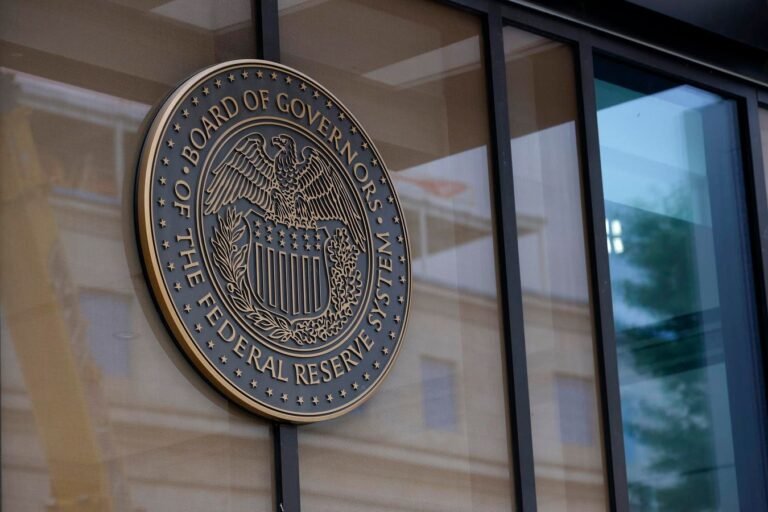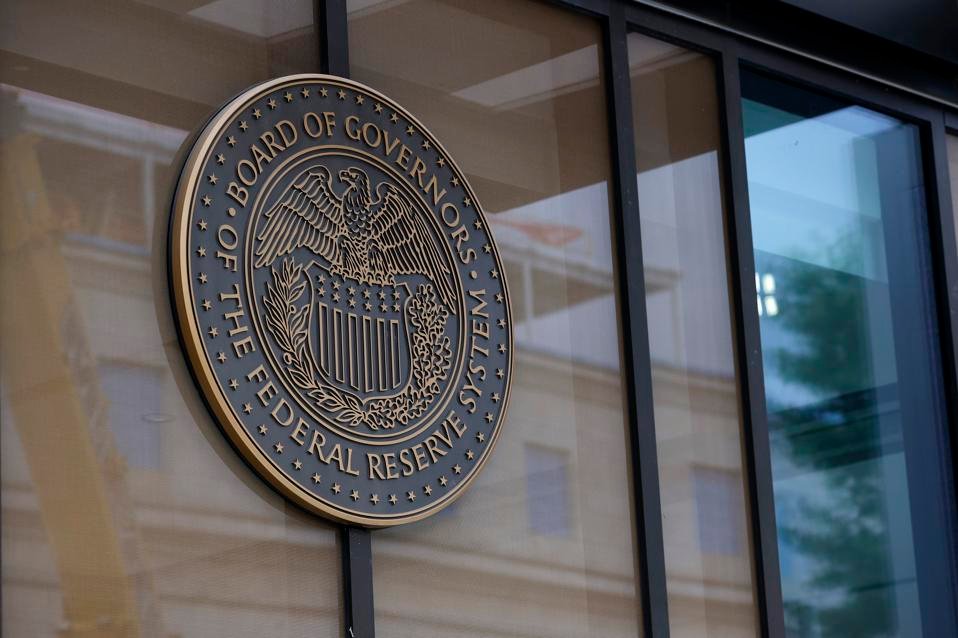WASHINGTON, DC: The Federal Reserve logo is seen on the William McChesney Martin Jr. Building on September 16, 2025 in Washington, DC. The Federal Open Market Committee (FOMC), the policy-making arm of the Federal Reserve, started its two-day meeting Tuesday and released its interest rate decision and policy statement today. (Photo by Kevin Dietsch/Getty Images)
Getty Images
With Wednesday’s announcement, the Federal Reserve has embarked upon a series of interest rate cuts that should continue through the balance of this year and into the third quarter of 2026—at least according to predictions from the financial markets.
This journey kicked off on Wednesday, with Fed Chair Jerome Powell concluding the Federal Open Market Committee (FOMC) September meeting with a 0.25% reduction in the fed funds target rate range to 4.00%-4.25%. Coming into the meeting, markets had a 0.25% rate cut priced in, meaning the markets were anticipating and looking for this size cut.
The Good And The Bad: How Do Fed Rate Cuts Impact Interest Rates?
Analyzing the data from the fed funds futures market, one can conclude that financial markets are looking for a steady decline in the U.S. central bank’s rate through 2026, bottoming out just below 3% at the end of 2026.
The message from the market is clear: Interest rates are going down.
The expected interest rate decline is both good and bad. The typical American household, with both short-term investments and a mortgage, will be impacted by this in two major ways: the interest rate on the amount of money they earn from investing and the amount of money they owe on loans such as mortgages.
In general, the lower rate on investments is not a good thing for those relying on the income for living expenses and other needs. However, a lower interest rate on loans, such as home mortgages, provides an immediate reduction in monthly payments.
What Is Bad About A Lower Interest Rate Environment?
A negative impact of lower rates is the lower interest income from bank accounts and money market funds. The average yield on the largest money market funds is 4.08% as of September 11, 2025, according to Bloomberg and Fidelis Capital.
This yield is appealing when compared to inflation. According to the most recent Consumer Price Index (CPI) release, Core CPI (all goods excluding food and energy) was 3.1% year-over-year in August. This means the average real rate (nominal yield minus the inflation rate) is about 1%.
The current high rate on money market funds has been a boon for income-sensitive investors. The Investment Company Institute reports that the amount of assets invested in money market funds is currently over $7.3 trillion, a record amount, and up over $455 billion this year alone.
Why Money Market Funds Will Fall Out Of Favor
As the Fed starts to reduce interest rates, the yields on money market funds should also start to decline, more or less in lockstep. Historically, the average yield difference between the fed funds rate and larger money market funds has been about 0.20% since 2018. That is, money market funds tend to yield 0.20% less than the fed funds rate over time.
If we combine the expected future path of the fed funds rate and the average spread to money market rates, then one would expect money market fund yields to decline in the near term and move below 3% towards the latter part of 2026.
To be clear, the forecasting ability of the fed funds futures market over the long term is questionable, but for the near term, one should expect a decline in money market fund yields.
Money market fund yields are poised to decline in the near term and move below 3% toward the end of 2026.
Bloomberg/Fidelis Capital
How The Inverted Yield Curve Impacts Money Market Funds
Since the beginning of 2023, short-term maturity bonds, such as the 1-month Treasury bill, have been yielding more than longer-term bonds, like the 2-year Treasury, a situation defined as an “inverted yield curve.”
This is one of the reasons that money market funds have seen such tremendous inflows over the last few years. There was little incentive to invest in longer-term bonds since short-term rates offered higher yields.
But as front-end rates start to decline, the Treasury yield curve should become positively sloped, which means that longer-term rates should offer more attractive yields than shorter-term rates. (Historically, the Treasury yield curve has been positively sloped. The current inversion is an anomaly.)
Another way to look at where yields may be headed in the near term is the Treasury forward curve, which is a mathematical construction used to price futures and forward contracts.
This metric suggests that a year from now, the market is looking for a positively sloped curve with front-end rates lower than long-end rates. Granted, the forward curve has not been a good predictor, but it is useful in ascertaining current market views.
With the anticipated decline in income derived from money market funds and similar short-term investments, investors should begin to look for alternatives if they haven’t already.
Treasury futures suggest a return to a positively sloped yield curve this time next year, which means longer-term rates should offer more attractive yields than shorter-term rates.
Bloomberg/Fidelis Capital
How to Hedge Against The Impending Decline In Money Market Fund Yields
One of the simplest ways to avoid this looming decline is to lock in higher yields now by investing in longer-maturity bonds, assuming this is a match for the investor’s risk profile. While “moving out on the curve” may not initially offer meaningful additional yield, it should provide a higher level of stable income over the long term.
This is particularly true if the real rate on money market funds moves toward zero or even into negative territory. A negative real rate would occur if the inflation rate became larger than the amount of interest earned. If the CPI remains at current levels and the Fed cuts as markets expect, then we could see negative real rates for money market funds by the middle of 2026.
What Is Good About A Lower Interest Rate Environment?
On the positive side, lower interest rates offer the opportunity to borrow money cheaper. The ability to refinance a mortgage is a powerful tool for homeowners to reduce their monthly payments.
We expect that mortgage rates will decline further in 2026, building on the initial decline this year. According to Bankrate.com, the average 30-year mortgage rate dipped below 6.5% as of September 16, 2025, for the first time since February of 2023.
Mortgage refinancing activity has started to increase, according to the Mortgage Bankers Association. As I’ve previously discussed, mortgage rates are more correlated to the 10-year Treasury yield than the fed funds rate. In the past 20 years when the Fed has cut rates, mortgage rates have declined as well, particularly at the onset of Fed rate cuts.
Compared to the fed funds rate, the 10-year Treasury yield more closely tracks the average 30-year mortgage rate.
Bloomberg/Bankrate.com/Fidelis Capital
If the trajectory of interest rates declines as expected, then we would anticipate a pickup in real estate activity because one of the key inputs in housing affordability is lower financing costs. (See my most recent piece about the housing market for further information.)
The opportunity to refinance an existing mortgage may present itself to an increasing number of homeowners in 2026 as the likely decline in Treasury yields could push mortgage rates through 6% and potentially lower.
While it is unlikely that mortgage rates will drop as low as 4%, (because this would imply a 10-year Treasury rate of approximately 3% or lower[KH1] , which, as of now, is unlikely), we do anticipate that mortgage rates could move below 6% should the 10-year Treasury yield remain below 4% in 2026.
The Bottom Line: Mortgage Refinancing Is Around The Corner, Money Market Funds Will Fall Out Of Favor
While there are good and bad effects of a lower rate environment, the good outweighs the bad—it’s net positive.
You will pay less to borrow money but also earn less on investments in money market funds, bank deposits and other related short-term investments. However, by acting now to lock in longer-term interest rates, investors can help mitigate or avoid this foreseeable decline in interest income. In 2026, investors should also look to refinance higher-yielding debt.
There are certainly other beneficial effects of lower interest rates, which include a favorable environment for equities and other risk assets. These knock-on effects were not addressed in this piece and are also important to consider. Investors should consult their financial advisory team before making any investment decisions.


